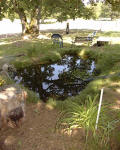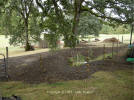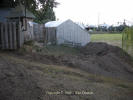|
|
Welcome to Dunton
Family Farms
|
|
Ponds and
Water Features Harvesting Rain Water |
|||
|
Interestingly, we watched the pond come alive. Water Skimmers, Water Beetles, Dragonflies, and frogs started moving in. We got three small baby koi fish and they turned into hundreds very quickly. However, through attrition, the population has stabilized at a few dozen. In the rainy season it kept filled up naturally. In the summer, we would use the hose which also helped with aeration. This was all an experiment. We had no prior knowledge of pond building, maintenance or management. We have learned a lot. For example, the clay seals the pond fine, but moles can still tunnel into it and cause leaks. This happens a lot. Lesson Learned: Pond liners!
The pond also is in the shadow of the cabin most of the time. It basically gets light in the early morning and late afternoon. I am not sure if this is good or bad but the pond seems to be healthy. We use no chemicals, aerate it by hand, do not feed the fish (there is plenty of plant and animal life for them) and do not breed mosquitoes or other objectionable insects. It has been a great learning experience and a cool addition to our landscape. It is fun to watch. But, we have bigger plans. The goal is to build a series of ponds that are functional. That is, along with bringing another aspect of the natural world to the farm, we intend to capture the rain water from all of our farm buildings and create a catchment system. [NOTE: One inch of rain on a 1,000 square foot roof is the equivalent of 623 gallons.] One idea we have is to create a large pond in the bottom field that could be used as a rain water reservoir to use for irrigation, maintaining water levels of the other two ponds, fire protection, wildlife habitat, and perhaps even recreation (swimming in and rowing on). Since it will be rainwater supplied, depending on the amount of water it maintains in the summer, raising fish for recreation and eating may be a possibility.
After it is constructed, we will create a "stream" connecting the upper (original) pond to the new middle pond as well as an underground pipe. The stream will allow water to flow to the middle pond and act as natural aeration. The pipe will allow water from the middle pond to be pumped back up the hill to the upper pond to complete the recirculation path. We intend to use solar and wind to accomplish these tasks. Once the middle pond is created, we will relocate all of the fish from the upper pond along with the plants (this time in pots). The first pond will then be drained, excavated and reconstructed again using the lessons that we have learned. The large, lower pond will need some serious planning and money to engineer and build. We will also need to investigate if any necessary governmental permissions are required. The first step is to complete the process of planting trees around the perimeter of the fields to act as a buffer and as a visual barrier. The lower pond is on our long-range plans. 9/3/09 - Not much progress on this project. As a result of excavating around the seedhouse for driveways and drainage lines, we ended up with about 80 cubic yards of fill. I got it all hauled down to the bottom of the hill and time permitting, worked at building up the upper pond and building a new, middle field access road that leads out from the barnyard. The remainder of the piles are roughly forming up the middle pond.
|
|||
|
Useful Links:
|












